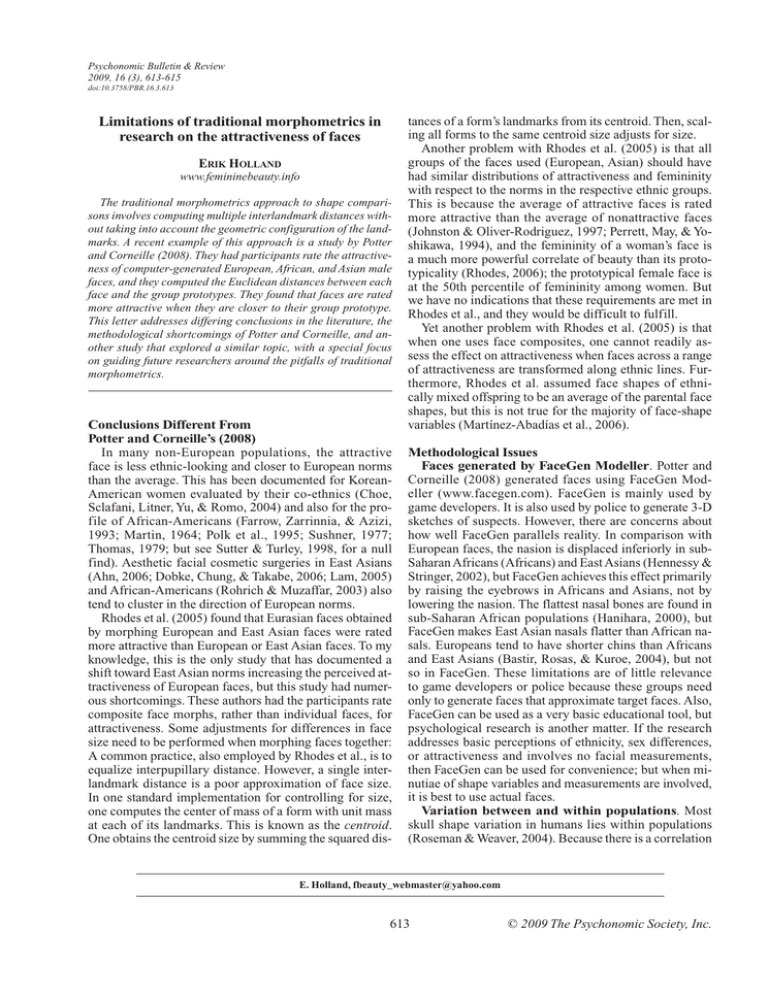
Psychonomic Bulletin & Review
2009, 16 (3), 613-615
doi:10.3758/PBR.16.3.613
Limitations of traditional morphometrics in
research on the attractiveness of faces
Erik Holland
www.femininebeauty.info
The traditional morphometrics approach to shape comparisons involves computing multiple interlandmark distances without taking into account the geometric configuration of the landmarks. A recent example of this approach is a study by Potter
and Corneille (2008). They had participants rate the attractiveness of computer-generated European, African, and Asian male
faces, and they computed the Euclidean distances between each
face and the group prototypes. They found that faces are rated
more attractive when they are closer to their group prototype.
This letter addresses differing conclusions in the literature, the
methodological shortcomings of Potter and Corneille, and another study that explored a similar topic, with a special focus
on guiding future researchers around the pitfalls of traditional
morphometrics.
Conclusions Different From
Potter and Corneille’s (2008)
In many non-European populations, the attractive
face is less ethnic-looking and closer to European norms
than the average. This has been documented for Korean­American women evaluated by their co-ethnics (Choe,
Sclafani, Litner, Yu, & Romo, 2004) and also for the profile of African-Americans (Farrow, Zarrinnia, & Azizi,
1993; Martin, 1964; Polk et al., 1995; Sushner, 1977;
Thomas, 1979; but see Sutter & Turley, 1998, for a null
find). Aesthetic facial cosmetic surgeries in East Asians
(Ahn, 2006; Dobke, Chung, & Takabe, 2006; Lam, 2005)
and African-Americans (Rohrich & Muzaffar, 2003) also
tend to cluster in the direction of European norms.
Rhodes et al. (2005) found that Eurasian faces obtained
by morphing European and East Asian faces were rated
more attractive than European or East Asian faces. To my
knowledge, this is the only study that has documented a
shift toward East Asian norms increasing the perceived attractiveness of European faces, but this study had numerous shortcomings. These authors had the participants rate
composite face morphs, rather than individual faces, for
attractiveness. Some adjustments for differences in face
size need to be performed when morphing faces together:
A common practice, also employed by Rhodes et al., is to
equalize interpupillary distance. However, a single interlandmark distance is a poor approximation of face size.
In one standard implementation for controlling for size,
one computes the center of mass of a form with unit mass
at each of its landmarks. This is known as the centroid.
One obtains the centroid size by summing the squared dis-
tances of a form’s landmarks from its centroid. Then, scaling all forms to the same centroid size adjusts for size.
Another problem with Rhodes et al. (2005) is that all
groups of the faces used (European, Asian) should have
had similar distributions of attractiveness and femininity
with respect to the norms in the respective ethnic groups.
This is because the average of attractive faces is rated
more attractive than the average of nonattractive faces
(Johnston & Oliver-Rodriguez, 1997; Perrett, May, & Yoshikawa, 1994), and the femininity of a woman’s face is
a much more powerful correlate of beauty than its prototypicality (Rhodes, 2006); the prototypical female face is
at the 50th percentile of femininity among women. But
we have no indications that these requirements are met in
Rhodes et al., and they would be difficult to fulfill.
Yet another problem with Rhodes et al. (2005) is that
when one uses face composites, one cannot readily assess the effect on attractiveness when faces across a range
of attractiveness are transformed along ethnic lines. Furthermore, Rhodes et al. assumed face shapes of ethnically mixed offspring to be an average of the parental face
shapes, but this is not true for the majority of face-shape
variables (Martínez-Abadías et al., 2006).
Methodological Issues
Faces generated by FaceGen Modeller. Potter and
Corneille (2008) generated faces using FaceGen Modeller (www.facegen.com). FaceGen is mainly used by
game developers. It is also used by police to generate 3-D
sketches of suspects. However, there are concerns about
how well FaceGen parallels reality. In comparison with
European faces, the nasion is displaced inferiorly in subSaharan Africans (Africans) and East Asians (Hennessy &
Stringer, 2002), but FaceGen achieves this effect primarily
by raising the eyebrows in Africans and Asians, not by
lowering the nasion. The flattest nasal bones are found in
sub-Saharan African populations (Hanihara, 2000), but
FaceGen makes East Asian nasals flatter than African nasals. Europeans tend to have shorter chins than Africans
and East Asians (Bastir, Rosas, & Kuroe, 2004), but not
so in FaceGen. These limitations are of little relevance
to game developers or police because these groups need
only to generate faces that approximate target faces. Also,
FaceGen can be used as a very basic educational tool, but
psychological research is another matter. If the research
addresses basic perceptions of ethnicity, sex differences,
or attractiveness and involves no facial measurements,
then FaceGen can be used for convenience; but when minutiae of shape variables and measurements are involved,
it is best to use actual faces.
Variation between and within populations. Most
skull shape variation in humans lies within populations
(Roseman & Weaver, 2004). Because there is a correlation
E. Holland, fbeauty_webmaster@yahoo.com
613
© 2009 The Psychonomic Society, Inc.
614 Holland
structure underlying differences between populations,
geographical clusters appear with the assessment of multiple interlandmark craniofacial distances (Brace & Hunt,
1990) or the geometric configuration of the landmarks
(Hennessy & Stringer, 2002). Nevertheless, there also is
clinal variation (Hanihara, 1996, 2000). Hence, with representative sampling of a population, it should be possible
to obtain faces that represent variation within this population, as well as faces somewhat shifted toward the norms
of other populations on multiple counts.
To investigate whether facial attractiveness varies along
the discriminant distinguishing ethnic groups, this component must be isolated from total face shape variation.
However, Rhodes et al. (2005) could not do this and, hence,
did not address the extent to which the higher attractiveness of Eurasian faces resulted from variation along the
discriminant distinguishing European from Asian faces,
rather than from other shape components. Potter and Corneille (2008) used the “rand lock” feature in FaceGen,
which keeps dimensions that are key to a group constant,
to generate random faces for each population. It is questionable how well FaceGen achieves this. If it does so well,
the authors did not have faces within a group that varied
among themselves along the discriminant distinguishing
this group from other groups and, hence, could not answer how attractiveness varies as a function of distance
from other-group prototypes. Even if FaceGen Modeller
had produced random faces within a group, so that a few
faces were, overall, somewhat shifted toward other-group
norms, then the authors would still have needed to control
for the within-population variation component in order to
answer their chief question.
Confounds between sexual dimorphism and ethnicity. In a sample of 29 human populations with 28 known
craniofacial measurements, the average distance between
populations (percentage difference per size-corrected measurement) was about 10 times greater than the average
distance between the sexes within populations (Sarich &
Miele, 2004). Therefore, face shape differences across the
major ethnic groups are predominantly associated with factors apart from sex hormones and other contributors to sexual dimorphism. Some interpopulation differences are in a
roughly similar direction as sex differences. For instance,
Europeans have more prominent nasal bones than those of
non-Europeans, but so do men, as compared with women.
Similarly, non-Europeans have less angular faces than those
of Europeans, but so do women, as compared with men.
Therefore, when considering face shape transformation
along ethnic lines, how can one determine whether, say, a
preference for less angular features is a preference for reduced masculinization or increased non-Europeanization?
Sexual dimorphism must be controlled for in such studies.
Suggestions for Future Studies
The best set of statistical tools for analyzing shape and
regressing shape components against variables of interest, such as attractiveness ratings, is geometric morphometrics (Bookstein, 1996; O’Higgins, 2000). Traditional
morphometrics ignores the geometric configuration of
the landmarks used for assessing interlandmark distances.
Geometric morphometrics captures information about the
geometric configuration of the landmarks by assessing a
shape in terms of its landmark coordinates and allows us
to define shape as a single point in n-dimensional space,
conveniently allowing multivariate analyses of shape
components and rigorous visualization of shape differences. In this shape space, the shape component or axis
joining the consensus shape of an ethnic group to the consensus shape of another ethnic group will be unaffected
by within-population variation and sexual dimorphism.
Regression analysis can then be used to assess whether
attractiveness varies along the axis.
An example of the utility of geometric morphometrics is
a shape analysis of European women’s face profiles, from
which three correlates of attractiveness were extracted:
averageness, above-average femininity, and a third element that the authors were unable to interpret (Valenzano,
Mennucci, Tartarelli, & Cellerino, 2006). The jaw shape
variables corresponding to the third element were previously documented in studies using composite face morphs
(Johnston & Franklin, 1993; Perrett et al., 1998) and were
assumed to be a sex hormone signal (Johnston & Franklin,
1993), but the third element did not contribute to sexual
dimorphism, even though many individual shape shifts
associated with the third element have been shown to be
affected by sexual dimorphism (Rosas & Bastir, 2002).
Thus, a shape component altering some parts of the face in
the same direction as sexual dimorphism, but not displaying the correlation structure underlying shape transformation resulting from sexual dimorphism, will be easily distinguished from sexual dimorphism if the morphometric
tool takes into account the geometric configuration of the
landmarks.
The third element was predominantly associated with
shifts that increased attractiveness in the jaw—a shorter but
more prominent chin, a regressed mouth (reduced alveolar
prognathism), and a more angled jaw—and also with shifts
toward slightly more prominent nasal bones. The third element thus corresponded to shifting the faces of European
women away from East Asian norms (Choe et al., 2004),
rather than toward it, and this was observed throughout the
range of European faces used, whereas the Rhodes et al.
(2005) approach at best informs us about the attractiveness
of the ethnic transformation of a particular (composite)
face. Whereas Valenzano et al. (2006) used face profiles,
they reported a strong correlation between frontal and profile attractiveness (Pearson’s r 5 .66, p , .0001).
How may one interpret the third element? A more angled jaw would have a more defined outline than a hyper­
feminine jawline (approximating a curve). The other shifts
are in the direction that discriminates humans from ancestral hominids, and aesthetic preferences lying along the
ancestral-to-derived discriminant have been documented
in both the face and the body (Magro, 1997, 1999). This
brings us to the interpretation of the literature that documents a shift toward European norms in attractive nonEuropean faces and is, therefore, discordant with Potter
and Corneille (2008). A convenient explanation is the
economic domination of Western societies and the strong
global presence of Western culture. However, northern
Notes and Comment 615
European slaves were admired for their looks in Rome
(Pitman, 2003), suggesting that desirable looks are not
necessarily associated with the socioeconomic elite. The
alternative explanation is that there is a preference for
somewhat more overall derived facial features in humans,
which parallels a shift toward European norms because
Europeans have more overall derived faces (Hanihara,
2000). Thus, European cultural hegemony does not necessarily fully account for why attractive non-European faces
are shifted toward European norms. Further research on
this topic will potentially be better if actual faces and geometric morphometrics are used. The actual faces can be
presented in the form of photographs or, better still, photogrammetric or laser scans of faces for 3-D assessments.
Author Note
Correspondence concerning this article should be addressed to E. Holland, P.O. Box 2994, Tempe, AZ 85280 (www.femininebeauty.info;
­e-mail: f beauty_webmaster@yahoo.com).
References
Ahn, J. M. (2006). The current trend in augmentation rhinoplasty. Facial
Plastic Surgery, 22, 61-69.
Bastir, M., Rosas, A., & Kuroe, K. (2004). Petrosal orientation and
mandibular ramus breadth: Evidence for an integrated petroso­mandibular developmental unit. American Journal of Physical Anthropology, 123, 340-350.
Bookstein, F. L. (1996). Biometrics, biomathematics and the morphometric synthesis. Bulletin of Mathematical Biology, 58, 313-365.
Brace, C. L., & Hunt, K. D. (1990). A nonracial craniofacial perspective on human variation: A(ustralia) to Z(uni). American Journal of
Physical Anthropology, 82, 341-360.
Choe, K. S., Sclafani, A. P., Litner, J. A., Yu, G.-P., & Romo, T., III
(2004). The Korean American woman’s face: Anthropometric measurements and quantitative analysis of facial aesthetics. Archives of
Facial Plastic Surgery, 6, 244-252.
Dobke, M., Chung, C., & Takabe, K. (2006). Facial aesthetic preferences among Asian women: Are all oriental Asians the same? Aesthetic Plastic Surgery, 30, 342-347.
Farrow, A. L., Zarrinnia, K., & Azizi, K. (1993). Bimaxillary protrusion in black Americans—An esthetic evaluation and the treatment
considerations. American Journal of Orthodontics & Dentofacial Orthopedics, 104, 240-250.
Hanihara, T. (1996). Comparison of craniofacial features of major
human groups. American Journal of Physical Anthropology, 99, 389412.
Hanihara, T. (2000). Frontal and facial flatness of major human populations. American Journal of Physical Anthropology, 111, 105-134.
Hennessy, R. J., & Stringer, C. B. (2002). Geometric morphometric
study of the regional variation of modern human craniofacial form.
American Journal of Physical Anthropology, 117, 37-48.
Johnston, V. S., & Franklin, M. (1993). Is beauty in the eye of the
beholder? Ethology & Sociobiology, 14, 183-199.
Johnston, V. S., & Oliver-Rodriguez, J. C. (1997). Facial beauty and
the late positive component of event-related potentials. Journal of Sex
Research, 34, 188-198.
Lam, S. M. (2005). Aesthetic facial surgery for the Asian male. Facial
Plastic Surgery, 21, 317-323.
Magro, A. M. (1997). Why Barbie is perceived as beautiful. Perceptual
& Motor Skills, 85, 363-374.
Magro, A. M. (1999). Evolutionary-derived anatomical characteristics
and universal attractiveness. Perceptual & Motor Skills, 88, 147-166.
Martin, J. G. (1964). Racial ethnocentrism and judgment of beauty.
Journal of Social Psychology, 63, 59-63.
Martínez-Abadías, N., González-José, R., González-Martín, A.,
Van der Molen, S., Talavera, A., Hernández, P., & Hernández, M. (2006). Phenotypic evolution of human craniofacial morphology after admixture: A geometric morphometrics approach. American
Journal of Physical Anthropology, 129, 387-398.
O’Higgins, P. (2000). The study of morphological variation in the
hominid fossil record: Biology, landmarks and geometry. Journal of
Anatomy, 197, 103-120.
Perrett, D. I., Lee, K. J., Penton-Voak, I., Rowland, D., Yoshikawa, S., Burt, D. M., et al. (1998). Effects of sexual dimorphism
on facial attractiveness. Nature, 394, 884-887.
Perrett, D. I., May, K. A., & Yoshikawa, S. (1994). Facial shape and
judgements of female attractiveness. Nature, 368, 239-242.
Pitman, J. (2003). On blondes. London: Bloomsbury.
Polk, M. S., Jr., Farman, A. G., Yancey, J. A., Gholston, L. R., Johnson, B. E., & Regennitter, F. J. (1995). Soft tissue profile: A survey
of African-American preference. American Journal of Orthodontics
& Dentofacial Orthopedics, 108, 90-101.
Potter, T., & Corneille, O. (2008). Locating attractiveness in the face
space: Faces are more attractive when closer to their group prototype.
Psychonomic Bulletin & Review, 15, 615-622.
Rhodes, G. (2006). The evolutionary psychology of facial beauty. Annual Review of Psychology, 57, 199-226.
Rhodes, G., Lee, K., Palermo, R., Weiss, M., Yoshikawa, S., Clissa, P.,
et al. (2005). Attractiveness of own-race, other-race, and mixed-race
faces. Perception, 34, 319-340.
Rohrich, R. J., & Muzaffar, A. R. (2003). Rhinoplasty in the AfricanAmerican patient. Plastic & Reconstructive Surgery, 111, 1322-1339.
Rosas, A., & Bastir, M. (2002). Thin-plate spline analysis of allometry
and sexual dimorphism in the human craniofacial complex. American
Journal of Physical Anthropology, 117, 236-245.
Roseman, C. C., & Weaver, T. D. (2004). Multivariate apportionment
of global human craniometric diversity. American Journal of Physical
Anthropology, 125, 257-263.
Sarich, V., & Miele, F. (2004). Race: The reality of human differences.
Boulder, CO: Westview Press.
Sushner, N. I. (1977). A photographic study of the soft-tissue profile
of the Negro population. American Journal of Orthodontics, 72, 373385.
Sutter, R. E., Jr., & Turley, P. K. (1998). Soft tissue evaluation of
contemporary Caucasian and African American female facial profiles. Angle Orthodontist, 68, 487-496.
Thomas, R. G. (1979). An evaluation of the soft-tissue facial profile in
the North American black woman. American Journal of Orthodontics,
76, 84-94.
Valenzano, D. R., Mennucci, A., Tartarelli, G., & Cellerino, A.
(2006). Shape analysis of female facial attractiveness. Vision Research, 46, 1282-1291.
(Manuscript received July 16, 2008;
revision accepted for publication February 5, 2009.)




